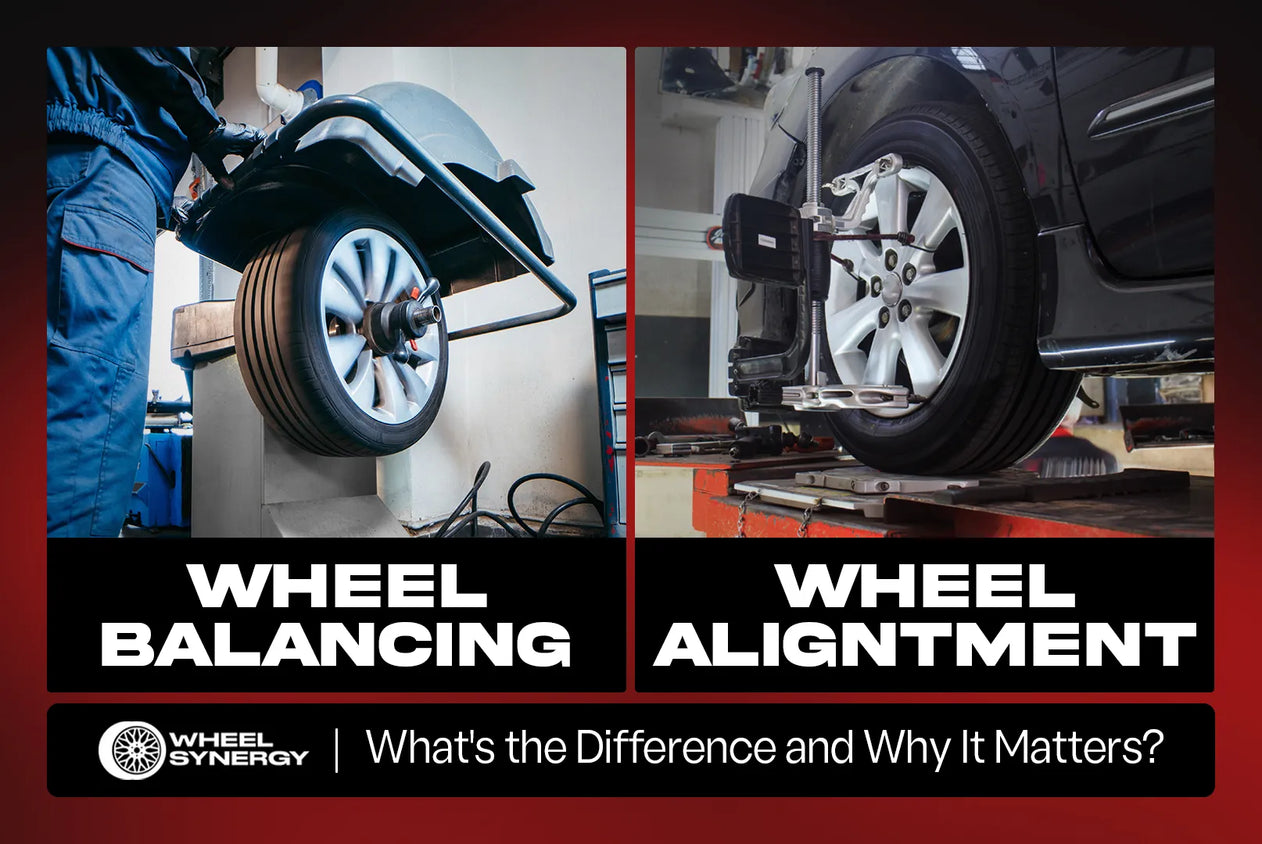Understanding the Difference: Wheel Balancing Vs Wheel Alignment
Wheel balancing and wheel alignment are two distinct procedures used in vehicle maintenance. Wheel balancing ensures equal weight distribution on all tires, while wheel alignment ensures proper alignment of the tires with the road.

Credit: www.wheelsynergy.com
Importance Of Wheel Balancing
Ensuring proper balance of your vehicle’s tires is essential for a smooth and safe driving experience. Wheel balancing helps prevent uneven wear and tear on your tires,
contributing to extended tire lifespan and better overall performance. Maintaining balance in your wheels also ensures optimal handling and control of your vehicle on the road.
Even Tire Wear
When your wheels are balanced correctly, they wear uniformly, preventing issues such as cupping or scalloping that can occur with imbalanced tires.
Smooth Ride
Proper wheel balancing results in a comfortable and smooth ride by minimizing vibrations and potential shaking caused by imbalanced tires.

Credit: www.tyreplus-me.com
Signs Of Imbalanced Wheels
When it comes to maintaining your vehicle’s performance and safety, understanding the difference between wheel balancing and wheel alignment is essential. Both wheel balancing and wheel alignment play crucial roles in ensuring your wheels are in optimal condition. In this blog post, we will focus on the signs of imbalanced wheels, helping you identify when it’s time to seek professional assistance. Let’s explore the two most common signs of imbalanced wheels: vibration at high speeds and uneven tire wear.
Vibration At High Speeds
One of the most noticeable signs of an imbalanced wheel is experiencing vibrations through your steering wheel or vehicle’s floorboards, particularly when driving at higher speeds. These vibrations occur due to uneven weight distribution on the wheels. When a wheel is out of balance, it causes the tire to wobble and results in these unwanted vibrations. It’s crucial to address this issue promptly as prolonged imbalanced wheels can lead to significant damage to other vehicle components, including suspension and steering systems.
Uneven Tire Wear
Another telltale sign of imbalanced wheels is uneven tire wear. When the weight isn’t distributed evenly across the tire, certain areas of the tire endure excessive pressure, leading to uneven wear patterns. Over time, this can cause premature tire wear, reducing their lifespan. Inspecting your tires regularly for signs of uneven wear, such as bald spots or worn edges, can help you identify if your wheels are imbalanced. Seeking professional help for wheel balancing will not only extend the life of your tires but also improve overall vehicle handling and fuel efficiency.
Benefits Of Wheel Alignment
Ensure smooth and safe driving with the benefits of wheel alignment. It involves adjusting the angles of the wheels to prevent uneven wear and tear, improve fuel efficiency, and extend tire lifespan. Proper wheel balancing, on the other hand, ensures equal weight distribution, contributing to a smoother ride and enhanced tire longevity.
Improved Handling
One of the primary benefits of wheel alignment is improved handling. When your wheels are properly aligned, your vehicle will be easier to control, especially during turns and maneuvers. This is because aligned wheels ensure that your tires are in optimal contact with the road surface at all times, allowing for better traction and stability. As a result, you’ll experience smoother and more precise steering, giving you a greater sense of confidence and control on the road.
Enhanced Tire Longevity
Investing in regular wheel alignment can significantly extend the lifespan of your tires. When your wheels are out of alignment, specific parts of the tires may wear down faster and unevenly. As a result, you may experience premature tire wear, such as uneven tread wear or bald spots. This not only compromises the performance of your tires but also requires you to replace them more frequently, leading to unnecessary expenses. By ensuring proper wheel alignment, you can maximize the lifespan of your tires, saving you money in the long run.
Consequences Of Misaligned Wheels
When wheels are misaligned, several consequences can occur that impact the performance and safety of your vehicle. Understanding the Consequences of Misaligned Wheels is crucial for maintaining optimal driving conditions.
Uneven Tire Wear
Uneven tire wear is a common outcome of misaligned wheels where certain parts of the tires experience more friction, causing tread to diminish unevenly and requiring premature tire replacements.
Poor Steering Response
Misaligned wheels can lead to poor steering response, making it challenging to maintain control of the vehicle, especially at higher speeds, increasing the risk of accidents.

Credit: www.autotrainingcentre.com
Frequently Asked Questions For Understanding The Difference: Wheel Balancing Vs Wheel Alignment
How Do I Know If I Need A Balance Or Alignment?
Imbalanced or uneven tire wear, steering vibration, or pulling to one side indicates the need for a balance or alignment. Regular checks ensure optimal vehicle performance and safety.
Which Is More Important Wheel Balancing Or Alignment?
Wheel balancing is more important for even tire wear and smooth driving. Alignment ensures proper steering and handling. Both are essential for overall vehicle performance.
What Should I Do First Alignment Or Balancing?
It is recommended to do alignment before balancing. Alignment ensures that the wheels are properly positioned, while balancing ensures even weight distribution on the tires. Doing alignment first helps to prevent vibrations and uneven tire wear.
Is Wheel Alignment Necessary After Wheel Balancing?
Wheel alignment is not necessary after wheel balancing. Wheel balancing ensures even weight distribution, while wheel alignment ensures proper alignment and positioning. Both are important for optimal performance and safety, but they are separate procedures.
Conclusion
Wheel balancing and wheel alignment are crucial for optimal vehicle performance. Understanding the differences between them can help you maintain your vehicle’s safety and efficiency. Regular maintenance of both aspects will ensure a smoother and safer driving experience for years to come.

